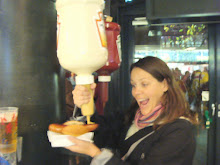According to experts, using the proper glassware is important because it concentrates the foam, accents the color, and helps to heighten the olfactory experience. When the beer is poured, hidden nuances are highlighted and the type of glass helps to supply a better, more complex drinking, experience.
Here's a quick run down of which glass is best for which beer:
- Flutes: The long, narrow bodies reduce the speed of carbonation dissipation; they generally have shorter stems then champagne glasses; flutes can be used for some Bocks, Pilsners, and Lagers
- Goblets: Delicate or heavy, plain or adorned, simple or sculptural stems — the options for this type of glass are endless; what all beer goblets have in common is that they are designed to maintain the beer's head; goblets are used for IPAs and dark ales
- Mugs and steins: Big, sturdy, and heavy mugs — and steins, their older, stone cousins — have handles that allow for serious toasting (not to mention the development of the arms of waitresses who can upwards of five mugs per hand to thirsty revelers); mugs can be used for Lagers, Ales, and Pilsners
- Pilsner glass: Tall, thin, and tapered, these 12-ounce glasses are meant to capture the carbonation and colors of Pils while maintaining its head; sometimes they have a short stems; in addition to Pils, they can be used for Lagers and Bocks
- Pint glasses: Cylindrical, with a slight taper and wide-mouth, pints are either 16 or 20 ounces; they are designed to accommodate beers with large, crowning heads and are easy to drink out of; pint glasses can be used for Ales, Lagers, Stouts, and IPAs
- Snifters: These wide-bowled, stemmed glasses with tapered mouths are designed to capture aromas; with a range of sizes, beers served in snifters can be swirled to agitate the volatiles; generally used for strong Ales, Stouts, and Imperial IPAs
- Stanges: From the German word for stick, a stange is a tall, thin, cylindrical glass designed to bring out the hops and malt in delicate beers; better known in the Bonn/Cologne area as a Kölsh glass, they can also be used for Lambics, Pils, or Gueuzes
- Tulips: These stemmed glass capture the head in the top of the glass and the body in the bulbous portion; they are used for Ales, particularly Scotch Ales, and IPAs
- Weizens: These tall, thin-walled glasses showcase the beer's color and allows for large heads; most are 0.5 liters and are meant to lock in the aromas; used for wheat beers (Weizens)





No comments:
Post a Comment